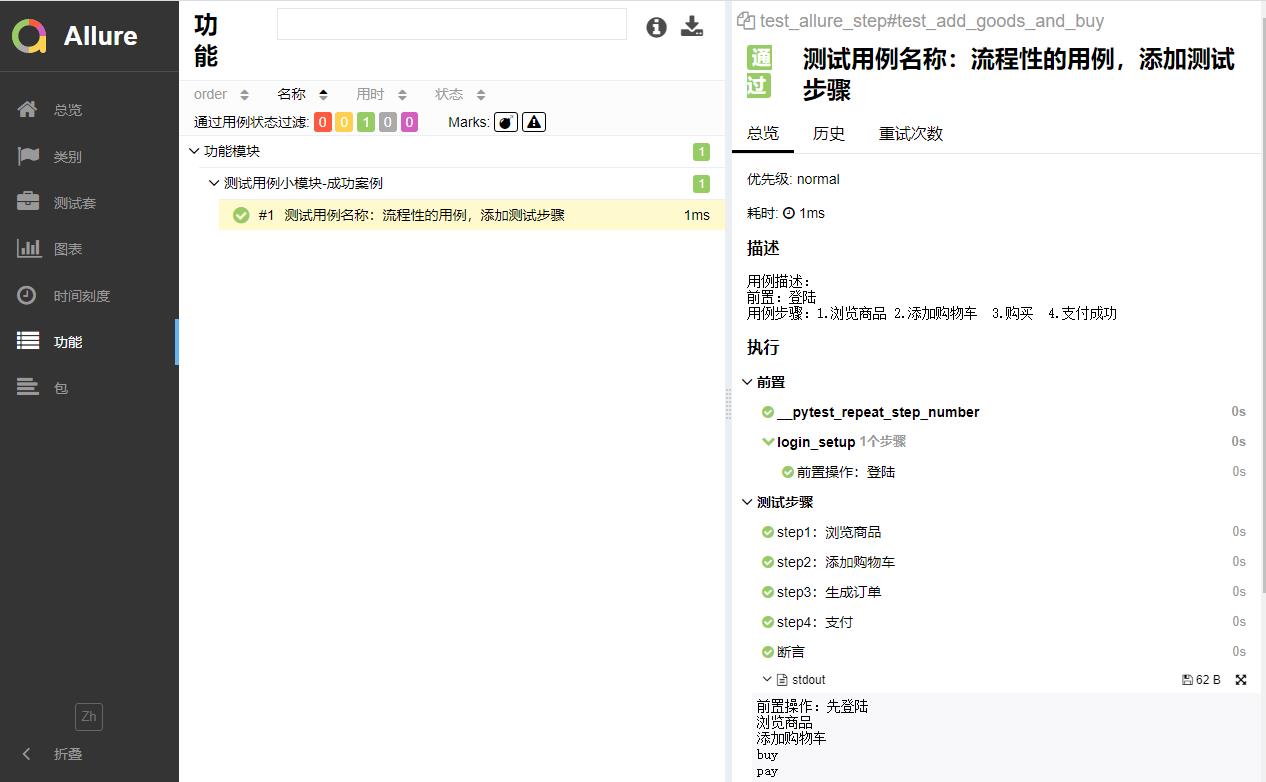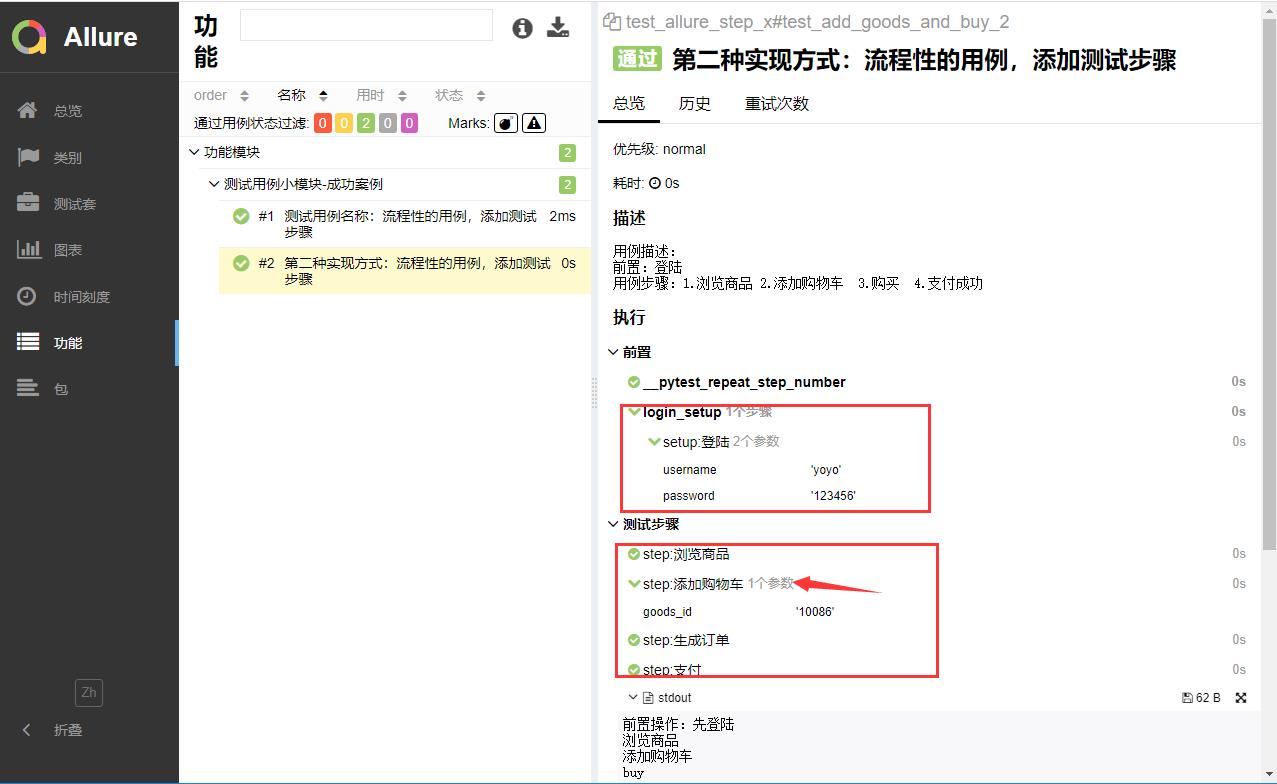pytest文档38-allure.step()添加测试用例步骤
Posted 上海-悠悠
tags:
篇首语:本文由小常识网(cha138.com)小编为大家整理,主要介绍了pytest文档38-allure.step()添加测试用例步骤相关的知识,希望对你有一定的参考价值。
前言
一般流程性的测试用例,写成自动化用例时,步骤较多写起来会比较长。在测试用例里面添加详细的步骤有助于更好的阅读,也方便报错后快速的定位到问题。
举个常见的测试场景用例:从登陆开始,到浏览商品添加购物车,最后下单支付
用例步骤:1.登陆, 2.浏览商品 3.添加购物车 4.生成订单 5.支付成功
用例设计
先把上面的每个环节,写成函数放到common_fucntion.py
# common_fucntion.py
import allure
import pytest
'''
流程性的用例,添加测试步骤,让用例更清晰
用例步骤:1.登陆, 2.浏览商品 3.添加购物车 4.生成订单 5.支付成功
作者:上海-悠悠 QQ交流群:779429633
'''
def login(username, password):
'''登陆'''
print("前置操作:先登陆")
def open_goods():
'''浏览商品'''
print("浏览商品")
def add_shopping_cart(goods_id="10086"):
'''添加购物车'''
print("添加购物车")
def buy_goods():
'''生成订单'''
print("buy")
def pay_goods():
'''支付'''
print("pay")
接下来测试用例设计,登陆可以单独拿出来,当成前置操作,后面的步骤合起来就是一个用例test_allure_step.py
# test_allure_step.py
import allure
import pytest
from .common_function import *
'''
流程性的用例,添加测试步骤,让用例更清晰
用例步骤:1.登陆, 2.浏览商品 3.添加购物车 4.生成订单 5.支付成功
作者:上海-悠悠 QQ交流群:779429633
'''
@pytest.fixture(scope="session")
def login_setup():
login("yoyo", "123456")
@allure.feature("功能模块")
@allure.story("测试用例小模块-成功案例")
@allure.title("测试用例名称:流程性的用例,添加测试步骤")
def test_add_goods_and_buy(login_setup):
'''
用例描述:
前置:登陆
用例步骤:1.浏览商品 2.添加购物车 3.购买 4.支付成功
'''
with allure.step("step1:浏览商品"):
open_goods()
with allure.step("step2:添加购物车"):
add_shopping_cart()
with allure.step("step3:生成订单"):
buy_goods()
with allure.step("step4:支付"):
pay_goods()
with allure.step("断言"):
assert 1 == 1
执行用例,生成allure报告
> pytest --alluredir ./allure_report test_allure_step.py
> allure serve ./allure_report
报告展示效果如下

测试步骤@allure.step()
测试步骤也可以在 common_fucntion.py 里面定义的函数上加上装饰器实现:@allure.step()
import allure
import pytest
'''
流程性的用例,添加测试步骤,让用例更清晰
用例步骤:1.登陆, 2.浏览商品 3.添加购物车 4.生成订单 5.支付成功
'''
@allure.step("setup:登陆")
def login(username, password):
'''登陆'''
print("前置操作:先登陆")
@allure.step("step:浏览商品")
def open_goods():
'''浏览商品'''
print("浏览商品")
@allure.step("step:添加购物车")
def add_shopping_cart(goods_id="10086"):
'''添加购物车'''
print("添加购物车")
@allure.step("step:生成订单")
def buy_goods():
'''生成订单'''
print("buy")
@allure.step("step:支付")
def pay_goods():
'''支付'''
print("pay")
测试用例设计 test_allure_step_x.py
import allure
import pytest
from .common_function import *
# 作者:上海-悠悠 QQ交流群:779429633
@pytest.fixture(scope="session")
def login_setup():
login("yoyo", "123456")
@allure.feature("功能模块")
@allure.story("测试用例小模块-成功案例")
@allure.title("第二种实现方式:流程性的用例,添加测试步骤")
def test_add_goods_and_buy_2(login_setup):
'''
用例描述:
前置:登陆
用例步骤:1.浏览商品 2.添加购物车 3.购买 4.支付成功
'''
open_goods()
add_shopping_cart(goods_id="10086")
buy_goods()
pay_goods()
assert 1 == 1
执行用例,生成allure报告
> pytest --alluredir ./allure_report test_allure_step_x.py
> allure serve ./allure_report
报告展示效果如下

两种方式对比
使用 with allure.step("step:步骤") 这种方式代码可读性更好一点,但不会带上函数里面的传参和对应的值。
使用 @allure.step("step:步骤") 这种方式会带上函数的传参和对应的值。
这两种方式结合起来使用,才能更好的展示测试报告!
以上是关于pytest文档38-allure.step()添加测试用例步骤的主要内容,如果未能解决你的问题,请参考以下文章